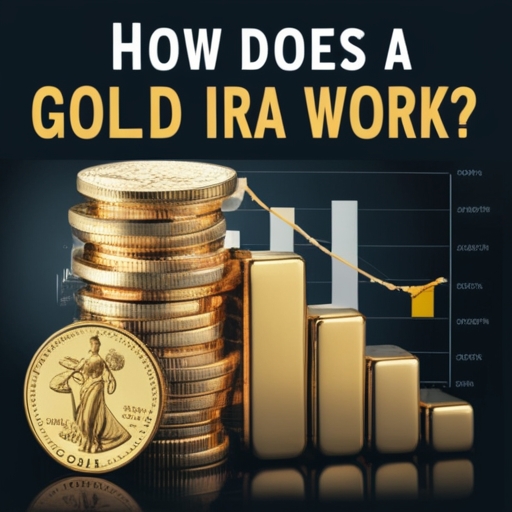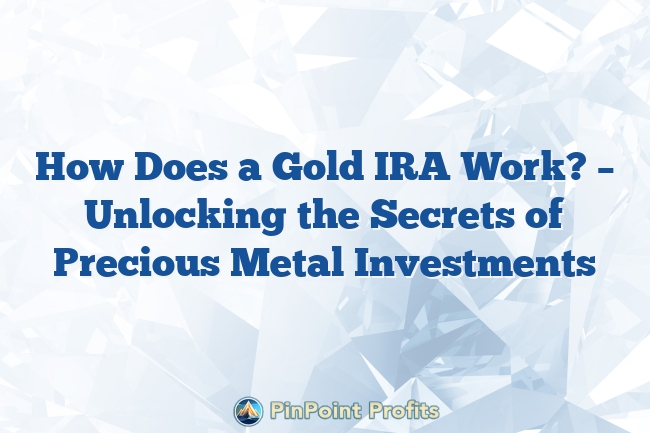If you're looking to add more gold to your IRA, then you're in the right spot. This guide will walk you through everything you need to know about Gold IRAs. Let's dive into the specifics without venturing into broader topics.
What is a Gold IRA?
A Gold IRA is a type of self-directed IRA that allows you to invest in physical gold and other precious metals. Unlike traditional IRAs, which typically hold stocks and bonds, a Gold IRA holds IRS-approved gold, such as gold bullion and coins. This alternative investment is a popular choice for those looking to diversify their retirement portfolio.
Gold IRAs offer a unique way to hedge against inflation and protect your assets. By investing in a Gold IRA, you can benefit from the stability and security that gold provides. It's a safe-haven asset that can help preserve your wealth over time.
| Feature | Gold IRA | Traditional IRA |
|---|---|---|
| Investment Type | Physical Gold | Stocks & Bonds |
| Inflation Protection | Yes | No |
| Portfolio Diversification | High | Moderate |
| IRS Regulations | Strict | Standard |
Benefits of Investing in Precious Metals
Investing in precious metals offers several advantages. One of the primary benefits is portfolio diversification. By including gold and other metals in your retirement portfolio, you can reduce risk and increase stability.
Precious metals are known for their ability to retain value over time, making them a reliable investment. Another benefit is the potential for inflation protection. Gold and other metals often perform well during periods of economic uncertainty.
They act as a hedge against inflation, preserving your purchasing power. Additionally, precious metals can provide tax-deferred investment opportunities, allowing your wealth to grow without immediate tax implications.

How to Set Up a Gold IRA
Setting up a Gold IRA involves a few key steps. First, you'll need to choose an IRA custodian who specializes in precious metals IRAs. This custodian will help you navigate the process and ensure compliance with IRS regulations.
Once you've selected a custodian, you'll need to fund your account. This can be done through an IRA rollover or a direct contribution. After funding your account, you can begin purchasing gold and other precious metals.
It's important to choose IRS-approved gold, such as gold coins or bars, to ensure compliance. Your custodian will assist with the purchase and storage of your metals, ensuring they are held in a secure precious metals depository.
Types of Precious Metals Allowed
When investing in a Gold IRA, it's crucial to understand the types of precious metals allowed. The IRS has specific guidelines regarding which metals can be included in a self-directed IRA. Generally, you can invest in gold, silver, platinum, and palladium.
However, these metals must meet certain purity standards. Gold must be at least 99.5% pure, while silver must be 99.9% pure. Platinum and palladium must also meet a purity standard of 99.95%.
It's essential to work with a reputable metals exchange to ensure you're purchasing IRS-approved metals. This will help you avoid any potential issues with your Gold IRA.
Tax Implications of a Gold IRA
Understanding the tax implications of a Gold IRA is crucial for effective investment planning. Contributions to a Gold IRA are typically tax-deductible, providing immediate tax benefits. However, it's important to be aware of IRA contribution limits, which can affect your tax strategy.
Withdrawals from a Gold IRA are subject to taxation. If you withdraw funds before the age of 59½, you may face additional penalties. It's essential to plan your withdrawals carefully to minimize tax liabilities.
A Gold IRA can offer significant IRA tax advantages, but it's important to understand the rules and regulations.
Risks Involved in Precious Metal Investments
While investing in precious metals offers many benefits, it's not without risks. One of the primary risks is market volatility. The value of gold and other metals can fluctuate, impacting your investment's performance.
It's important to have a solid gold investment strategy to mitigate these risks. Another risk is the potential for theft or loss. Physical gold storage requires careful consideration to ensure your assets are protected.
Working with a reputable custodian and using a secure depository can help minimize these risks. It's also important to stay informed about market trends and adjust your strategy as needed.
Choosing a Custodian for Your Gold IRA
Selecting the right custodian for your Gold IRA is a critical decision. A good custodian will provide custodial services that ensure compliance with IRS regulations. They will also offer guidance on purchasing and storing your precious metals.
When choosing a custodian, consider their reputation and experience in handling precious metals IRAs. Look for a custodian with a strong track record and positive customer reviews.
It's also important to compare fees and services to ensure you're getting the best value for your investment.
Storage Options for Precious Metals
Proper storage of your precious metals is essential for protecting your investment. There are several storage options available, each with its own advantages and disadvantages. One option is to use a precious metals depository, which offers secure storage and insurance coverage.
Another option is to store your metals at home. While this provides immediate access, it also comes with increased risk. It's important to weigh the pros and cons of each option and choose the one that best fits your needs.
Working with your custodian can help you make an informed decision about physical gold storage.
How to Rollover an Existing IRA into a Gold IRA
Rolling over an existing IRA into a Gold IRA is a straightforward process. First, you'll need to contact your current IRA provider and request a rollover. This involves transferring funds from your existing IRA to your new Gold IRA account.
Once the funds are transferred, you can begin purchasing gold and other precious metals. It's important to work with your custodian to ensure the rollover is completed smoothly and in compliance with IRS regulations.
This process allows you to diversify your retirement portfolio with minimal hassle. You may also consider a 401(k) rollover if you have funds in an employer-sponsored retirement plan.
Costs Associated with a Gold IRA
Investing in a Gold IRA comes with certain costs. These can include setup fees, annual maintenance fees, and storage fees. It's important to understand these costs and factor them into your investment strategy.
Setup fees are typically a one-time charge for establishing your Gold IRA account. Annual maintenance fees cover the ongoing management of your account.
Storage fees are associated with the secure storage of your precious metals. Comparing fees from different custodians can help you find the best deal for your precious metals IRA.
Comparing Gold IRAs to Traditional IRAs
Gold IRAs and traditional IRAs offer different benefits and drawbacks. A Gold IRA allows you to invest in physical gold, providing a hedge against inflation and market volatility. Traditional IRAs typically invest in stocks and bonds, offering growth potential but with higher risk.
When comparing the two, consider your investment goals and risk tolerance. A Gold IRA can provide stability and diversification, while a traditional IRA may offer higher returns.
It's important to weigh the pros and cons of each option and choose the one that aligns with your retirement strategy. You might also consider a Roth IRA for additional tax benefits.

Long-term Benefits of Precious Metal Investments
Investing in precious metals can offer significant long-term benefits. One of the primary advantages is asset preservation. Gold and other metals have a long history of retaining value, making them a reliable investment for the future.
Precious metals also provide inflation protection, helping to preserve your purchasing power over time. Additionally, they offer portfolio diversification, reducing risk and increasing stability.
By including precious metals in your retirement portfolio, you can enjoy these long-term benefits and secure your financial future.
Understanding Gold Spot Prices
The gold spot price is a crucial factor in Gold IRA investments. It represents the current market price for immediate delivery of gold. Understanding spot prices can help you make informed decisions about when to buy or sell gold for your IRA.
Spot prices fluctuate constantly based on various factors, including economic conditions, geopolitical events, and supply and demand. Keeping an eye on these prices can help you optimize your investment strategy.
Many investors use spot prices as a benchmark for evaluating the performance of their Gold IRA.
Gold ETFs vs. Physical Gold
When considering gold investments, you may encounter options like Gold ETFs (Exchange-Traded Funds). While Gold ETFs offer exposure to gold prices, they differ significantly from physical gold held in a Gold IRA.
Gold ETFs are financial instruments that track the price of gold, but they don't involve ownership of physical gold. In contrast, a Gold IRA allows you to own and store actual gold bullion or coins.
Each option has its advantages and drawbacks, and the choice depends on your investment goals and risk tolerance.
The Role of Gold Mining Stocks in Your Portfolio
While a Gold IRA focuses on physical gold, some investors also consider gold mining stocks as part of their precious metals strategy. These stocks represent ownership in companies that mine and produce gold.
Gold mining stocks can offer leveraged exposure to gold prices, potentially providing higher returns than physical gold. However, they also come with additional risks related to company performance and market factors.
Including gold mining stocks in your portfolio can complement your Gold IRA, offering a different avenue for precious metal exposure.
Navigating IRS Regulations for Gold IRAs
Understanding and complying with IRS regulations is crucial for maintaining a valid Gold IRA. The IRS has specific rules regarding the types of gold and other precious metals that can be held in an IRA, as well as storage requirements.
Failure to comply with these regulations can result in penalties and disqualification of your IRA. Working closely with a knowledgeable custodian can help ensure that your Gold IRA remains compliant with all relevant IRS rules.
Regular reviews of your account and staying informed about any regulatory changes are essential practices for Gold IRA investors.
Conclusion
In conclusion, a Gold IRA offers a unique opportunity to diversify your retirement portfolio with precious metals. By investing in IRS-approved gold, you can benefit from inflation protection, asset preservation, and portfolio diversification. Setting up a Gold IRA involves choosing a reputable custodian, purchasing approved metals, and ensuring secure storage.
While there are costs and risks associated with this investment, the long-term benefits can outweigh these challenges. By understanding the tax implications and carefully planning your strategy, you can maximize the potential of your Gold IRA. Whether you're rolling over an existing IRA or starting fresh, a Gold IRA can be a valuable addition to your retirement plan.
Frequently Asked Questions
What is the minimum investment for a Gold IRA?
The minimum investment for a Gold IRA varies by custodian. Some custodians may require a minimum investment of $5,000, while others may have higher or lower requirements. It's important to research and compare custodians to find one that fits your investment budget.
Can I store my Gold IRA metals at home?
Storing Gold IRA metals at home is generally not recommended. The IRS requires that precious metals in a Gold IRA be stored in an approved depository. Home storage can lead to penalties and disqualification of your IRA. It's best to use a secure depository for compliance and protection.
Are there any penalties for withdrawing from a Gold IRA early?
Yes, withdrawing from a Gold IRA before the age of 59½ can result in penalties. Early withdrawals are subject to income tax and an additional 10% penalty. It's important to plan your withdrawals carefully to avoid these penalties and maximize your investment's potential.

